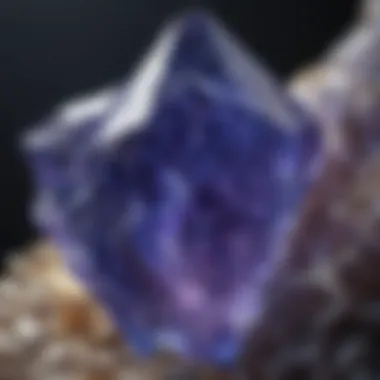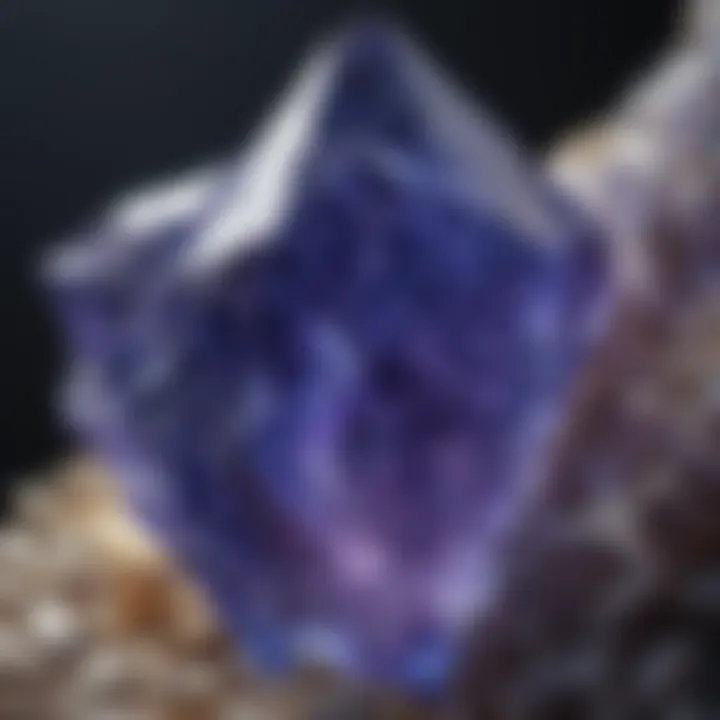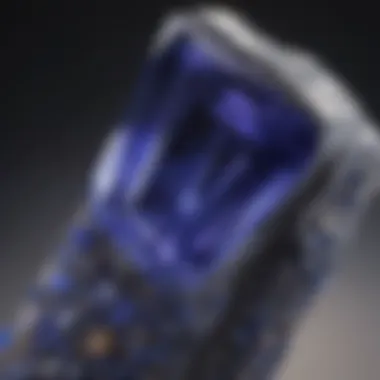Understanding Tanzanite Hardness: A Detailed Overview


Intro
Tanzanite, a gemstone that has captured the imagination of jewelers and collectors alike, stands out not only for its breathtaking color but also for its intricacies. Understanding the hardness of this gem provides essential insight into its durability and suitability for various applications in jewelry. This guide aims to explore tanzanite’s characteristics, particularly focusing on its hardness within the well-known Mohs scale. Let’s journey through the mineral composition and properties that give tanzanite its unique resilience.
Gemstone Overview
Definition and Characteristics
Tanzanite is a vibrant blue to violet gemstone belonging to the zoisite mineral family. Discovered in Tanzania in the 1960s, it has become a favorite among those who appreciate unique and rare gemstones. Its color ranges from rich royal blue to a soft violet, dependent on the angle of light and specific crystal orientation. The stone’s pleochroism—the ability to show different colors when viewed from different angles—further adds to its charm.
Classification of Gemstones
Gemstones are typically categorized based on various criteria such as mineral composition, brilliance, and clarity. Tanzanite falls under the category of precious gemstones, which include diamonds, sapphires, and emeralds. Each type has distinct features that contribute to its overall market value and desirability.
Tanzanite is likened to a sapphire in its beauty, yet it differs in its rarity and geological origins.
Properties of Gemstones
Physical Properties
The physical attributes of tanzanite are crucial in understanding its hardness and durability. On the Mohs hardness scale, tanzanite records a hardness of around 6-7, which means it can scratch glass but can be scratched by harder substances, like sapphires and diamonds.
Key physical properties of tanzanite include:
- Color: Vivid blue, violet, and shades in between.
- Transparency: Generally transparent to translucent.
- Luster: Vitreous to resinous.
Chemical Properties
Chemically, tanzanite is composed of calcium, aluminum, and silicate, resulting in its unique coloration and optical effects. The presence of vanadium is responsible for the stunning blue color which distinguishes it from other gemstones. This mineralogy is particularly important when assessing durability and care, as the stone can be sensitive to heat or harsh chemicals.
Understanding both the physical and chemical properties of tanzanite contributes to a richer knowledge of its utilization in jewelry and its overall value in the marketplace.
"The allure of tanzanite lies not just in its beauty, but in the stories it tells through its formation."
By comprehensively examining tanzanite's hardness and properties, jewelers can better appreciate how to care for this magnificent stone, while collectors gain valuable insights into what makes it a sound investment.
Foreword to Tanzanite
Tanzanite stands out in the realm of gemstones, not just for its mesmerizing color but also for its distinct properties. Its allure lies far deeper than just appearance; understanding tanzanite means delving into its foundational aspects—its definition, origin, and unique characteristics—that serve as the cornerstones of this guide. Recognizing these elements is crucial for gemstone enthusiasts, collectors, and jewelry designers who wish to appreciate the full spectrum of what tanzanite offers.
The significance of accurately defining tanzanite begins with its name. This gemstone, renowned for its vibrant hues, originates from a single source in Tanzania, making it not just rare but also a symbol of geographical pride. Moreover, with its fascinating formation process, one can appreciate why it commands such respect in the jewelry world.
Another facet worth exploring is the unique characteristics of tanzanite. This gemstone is known to exhibit a rare pleochroism, showcasing different colors from varying angles, which can be quite captivating. Understanding these traits becomes vital when assessing its value, durability, and application in jewelry designs. Grasping the essence of tanzanite establishes a strong foundation for everything that follows in this article’s discussion, including its hardness properties, practical considerations for jewelers, and the broader market implications.
Definition and Origin
Tanzanite, scientifically classified as a variety of the mineral zoisite, was first discovered in the 1960s in Tanzania's Merelani Hills. Its discovery opened a new chapter in the gem trade, with the gemstone quickly rising to prominence due not just to its beauty but also its limited geographical availability. With tanzanite being found exclusively in this central eastern African nation, it imparts a unique story—one of natural wonder and geological specificity.
The origin of its name is deeply tied to its source. The gemstone was named after its homeland, thus reinforcing its distinct identity in the gem market. The mining process itself is steeped in local culture and community, making tanzanite not merely a beautiful rock but a piece of Tanzania's heritage.
Unique Characteristics
Tanzanite possesses several unique characteristics that set it apart from other gemstones. One of its most notable features is its remarkable pleochroism, allowing the stone to display distinct shades of blue, purple, and burgundy depending on how light interacts with it. This phenomenon is rare and adds to the gemstone's visual appeal, causing collectors to seek after stones that exhibit strong color changes.
Additionally, tanzanite showcases transparency and brilliance, which are critical factors in determining its quality.
- Color Depth: The vibrancy linked to tanzanite is striking, and stones that exhibit darker, more saturated shades are considered more valuable.
- Specific Gravity: Tanzanite's unique density plays a role in its heft, making it feel more substantial than some other gemstones of similar size.
Tanzanite, with its rich color and unique optical effects, forever changes perceptions within the gemstone community. Understanding its definition and origin, alongside these captivating characteristics, will equip enthusiasts with the insights necessary for deeper exploration into the stone's hardness and overall durability.
The Mohs Hardness Scale
The Mohs Hardness Scale stands as a cornerstone in the world of gemology, offering a systematic way to understand the durability of various minerals, including the esteemed tanzanite. It is not just a random ranking; instead, it serves as a practical reference for gem enthusiasts and professionals alike, illustrating the resilience and vulnerability of stones under physical stress. Knowing where tanzanite fits into this scale helps in appreciating its strengths, care needs, and potential limitations in jewelry manufacturing and usage. This section illuminates the historical context that laid the groundwork for the scale's creation and its significant role in the gemological field.


Understanding the Scale
Historical Context
The journey of the Mohs Hardness Scale traces back to 1812, when the Austrian mineralogist Friedrich Mohs sought to categorize minerals based on their scratch resistance. This was not merely an academic pursuit but a practical one, aiming to aid miners and jewelers in identifying and working with different materials. One could say it’s akin to a professor giving marks to students, grading them on how tough they are against scratching.
This historical touchpoint highlights a key characteristic of the scale: its straightforward nature. Mohs selected ten reference minerals, ranging from talc (the softest) to diamond (the hardest), which makes it easy to visualize where a specific gemstone falls within the spectrum. It’s particularly beneficial for those not steeped in geology, as the simple 1-10 rating gives an approachable insight into material durability.
However, the scale does come with its quirks. For one thing, it’s not linear; the difference in hardness between each subsequent number is not equal. This unique feature can sometimes lead to misconceptions about hardness levels if one assumes a straightforward increase. For instance, a mineral rated 5 isn’t necessarily twice as hard as one rated 2. Such nuances remind us that while the scale is immensely helpful, it requires careful interpretation when applied.
Usage in Gemology
When it comes to gemology, the Mohs Hardness Scale is practically the bread and butter of the trade. It aids jewelers in determining the suitability of certain gemstones in various designs, ensuring durability while still achieving aesthetic appeal. In a world filled with exquisite stones like emeralds, sapphires, and of course, tanzanite, understanding their hardness becomes essential in the crafting process.
One key characteristic of this usage is its role in treatment and care recommendations. For example, if a jeweler knows that tanzanite is rated at 6 to 7 on the Mohs Scale, they can convey appropriate maintenance instructions to clients, promoting longevity and beauty. This practical aspect converts insights from the scale into actionable advice, which is essential for both buyers and craftsmen.
In terms of unique features, this practical application helps avoid potential pitfalls that could arise from carelessness. For instance, tanzanite can scratch easily when compared to sturdier gemstones like rubies or diamonds. Thus, neglecting its care due to its sheer beauty could lead to regrettable outcomes. The advantage of having such a scale at our disposal is clear: it offers the ability to select the right stones for specific settings while keeping practicality at the forefront.
Tanzanite's Placement
Comparative Hardness with Other Gemstones
When we dive into tanzanite's placement within the Mohs Hardness Scale, it’s important to compare it with its peers. Rated between 6 and 7, tanzanite finds itself in an intriguing middle ground, softer than sapphire, which is a hard 9, and harder than stones like amethyst and opal, which sit at about 7 and 5. In this light, we see tanzanite as somewhat of a delicate beauty—a striking color and brilliance, but with an inherent sensitivity to scratches.
This comparative hardness can be enlightening for buyers. The unique allure of tanzanite demands careful thought when paired with other gemstones in jewelry. Knowing that tanzanite is softer than many popular choices, jewelers can design settings that minimize risks of scratching or damage during daily wear. Thus, this aspect becomes not only informative but also a boon for jewelry designers working with a mixture of stones.
Implications of Hardness Level
The hardness level of tanzanite doesn't just pale in comparison to more robust stones; it also carries implications regarding its use, care, and overall longevity. A major takeaway is that tanzanite requires a harmonious approach when used in pieces intended for daily wear. Its moderate hardness suggests that, while it's beautiful, it demands a more gentle lifestyle—think along the lines of avoiding rough housing or exposure to abrasive materials.
Moreover, the implications extend to market considerations. Buyers should be well-informed about these properties, as possessing a more fragile stone influences its upkeep and overall value. But don’t let the softness fool you; it doesn’t diminish its fascination. Understanding tanzanite’s standing within the Mohs hardness framework elucidates both its enchanting charm and its protective needs. Utilizing this knowledge ensures that both collectors and jewelers can appreciate its beauty while safeguarding its integrity for years to come.
"A gemstone's beauty is more than skin-deep; it’s about understanding its world beneath the surface."
Physical Properties of Tanzanite
Understanding the physical properties of tanzanite is crucial for appreciating its beauty and durability. The interaction of its chemical makeup and crystal structure defines its overall appeal to gem enthusiasts and jewelers alike. This section delves into the core physical attributes that contribute to the gemstone's unique status in the market, providing insight into how these elements impact its desirability among collectors and designers.
Chemical Composition
Tanzanite’s chemical composition is fundamentally a mix of calcium, aluminum, and silicate with traces of vanadium, which is significant in imparting its vibrant colors ranging from deep blue to violet. The mineral holds the formula of
[ (Ca_2Al_3Si_3O_12(OH)) ]
This composition is essential in defining its strength and luster. Notably, it’s the vanadium ions that influence the stone’s rich hues, they provide a stunning visual appeal that catches the eye. The presence of these elements creates an intricate lattice structure, which not only enhances the color but also contributes to its hardness and durability on the Mohs scale, landing it at around 6 to 7. This hardness level is significant when considering the gemstone’s everyday use in jewelry, allowing it to withstand wear while maintaining its aesthetic charm.
Crystal Structure
Tanzanite is classified under the triclinic crystal system, which is one of the lesser-known structures in gemology. This means that its crystal lattice is shaped in a way that lacks symmetry, making it unique compared to other well-known gemstones like diamonds, which belong to the cubic system.
Triclinic System
The triclinic system features three unequal axes that intersect at oblique angles. This structure enhances tanzanite's ability to display pleochroism, a phenomenon where it shows different colors from different angles. This unique characteristic is a jewel in the crown for tanzanite, attracting gem lovers who appreciate complexity in their stones. Not only does this structural feature influence its visual appeal, but it also plays a role in its overall toughness and resilience in various settings.
"Tanzanite’s unique triclinic structure enhances its allure, inviting gem enthusiasts to explore its depth and color variations."
Influence on Hardness
The influence of the triclinic structure on tanzanite's hardness cannot be overstated. While the hardness on the Mohs scale indicates that this gem is somewhat softer than a sapphire or beryl, the intricate arrangement of its atoms contributes to a certain toughness, allowing it to endure daily wear. However, care must still be exercised due to its cleavage planes, which can make it vulnerable to chipping under stress. In jewelry-making, this characteristic is a double-edged sword; jewelers must design settings with this in mind to maximize the longevity of the stone while still showcasing its breathtaking aesthetics. Therefore, this awareness of both beauty and fragility is essential for those in the field to ensure tanzanite remains a viable choice for a wide range of applications.
Durability Factors
Understanding the durability factors of tanzanite is paramount not only for enthusiasts but also for collectors and jewelers who may work with this spectacular gemstone. The durability of tanzanite affects its suitability for various types of jewelry, its longevity, and how it is perceived in terms of value. Durability generally encompasses three main components: cleavage, resistance to abrasion, and heat sensitivity. Each of these characteristics has distinct implications on the practical usage of tanzanite in the gemological world.
Cleavage and Fracture


Tanzanite's cleavage and fracture characteristics are crucial when evaluating its overall durability. Cleavage refers to the way a gemstone breaks along specific planes, while fracture describes how it breaks in an irregular pattern when cleavage does not occur.
For tanzanite, its cleavage tends to be imperfect, leading to potential weaknesses that could be considered when setting the stone in jewelry. This imperfect cleavage means it can chip or break if subjected to significant force or impact.
- Key Points about Cleavage and Fracture in Tanzanite:
- Imperfect cleavage can lead to the possibility of chipping.
- Fractures may not always be visible immediately, which raises concerns for long-term wear.
- When setting, it’s advisable to choose designs that minimize the likelihood of direct impact.
Resistance to Abrasion
Tanzanite's resistance to abrasion reflects its ability to withstand wear and tear over time. This aspect of durability is particularly important for stones that will be worn frequently, such as rings or bracelets.
On the Mohs hardness scale, tanzanite has a rating of about 6 to 7, which indicates a moderate level of resistance to scratches. While it is relatively durable compared to softer stones, it is susceptible to scratches from harder minerals or materials. Jewelers need to consider this when designing settings or advising clients.
- Practical Considerations for Resistance to Abrasion:
- Select tanzanite pieces for casual wear thoughtfully, avoiding settings prone to exposure to harder objects.
- Regular cleaning can help maintain the stone’s luster; however, avoid using harsh chemicals.
Heat Sensitivity
The sensitivity of tanzanite to heat is another essential factor for both jewelers and buyers. Prolonged exposure to high temperatures can alter its color and clarity, indicating that care must be taken throughout the jewelry-making and wearing processes.
For instance, if a tanzanite stone is subjected to intense heat during repairs or in environments like saunas, it could lead to permanent damage. This factor particularly influences how one should care for and maintain pieces made from this gemstone.
- Considerations for Heat Sensitivity in Tanzanite:
- Avoid exposing tanzanite jewelry to steam or high temperatures.
- Store pieces in cooler environments to help retain their beauty over time.
"Understanding the durability factors of tanzanite can save both collectors and jewelers from future headaches, ensuring that these stunning gems retain their beauty and structural integrity."
By considering these durability factors, one can appreciate the exceptional qualities of tanzanite while also understanding the necessary precautions that should be taken to preserve its allure.
Practical Considerations for Jewelers
When it comes to working with tanzanite, jewelers find themselves navigating a fascinating yet challenging gemstone landscape. Understanding practicalities is essential; tanzanite, while stunning, requires careful handling and thoughtful approaches during both the crafting and selling processes.
First off, setting tanzanite into jewelry isn't as simple as it may appear. Given its relative softness on the Mohs scale, jewelers need to opt for secure settings that offer protection to the stone. Bezel settings, for instance, are often preferred over prong settings as they shield more of the stone’s edges from potential chips and scratches. Thus, jewelers should consider the durability needs of customers while keeping elegance in mind.
Another significant aspect is the care that comes after the jewelry is created. To preserve tanzanite's beauty, jewelers often recommend specialized cleaning products that avoid harsh chemicals. A gentle soap solution paired with a soft brush is generally suggested. It's advisable not to expose this stone to extreme heat or sudden temperature changes, as these can lead to structural weakening over time.
"Protecting your investment is just as important as the design itself. A well-set, well-cared-for stone is not only more pleasing to the eye, but it also retains its value much better."
Setting and Care
The actual process of setting tanzanite requires an eye for aesthetics as well as practicality. Jewelers must consider the color and clarity of the tanzanite being used. Deeper hues are often more desirable, commanding higher prices in the market. Setting the stone in such a way that allows the natural brilliance to shine through is key.
It's common for jewelers to work with designs that complement tanzanite, using metals like white gold or platinum, which highlight the stone’s unique bluish-purple tones spectacularly. Additionally, ensuring the stone is protected during the cutting and polishing processes can minimize the risk of damage. Jewelers need to take deliberate care at every step, keeping in mind tanzanite's fragility.
Identifying Quality Stones
In the realm of gemstones, the quality of tanzanite can differ significantly. Jewelers play a crucial role in helping customers identify top-quality stones, which can only enhance their credibility and reputation. Key characteristics to consider include color saturation, clarity, and cut. A gem with a deep blue or violet hue is often most sought after.
A clear examination of clarity will help distinguish quality stones. Jewelers can guide their clients through what constitutes inclusions and how these tiny blemishes can affect a gemstone’s overall appearance.
When it comes to cut, the arrangement of facets on a tanzanite affects light reflection and refraction. A well-cut tanzanite enhances brilliance and displays the stone’s vivid color more effectively, which is something jewelers should emphasize to their clients.
In addition, awareness of market trends and pricing can help jewelers provide relevant advice to customers, ensuring they invest wisely. Jewelers who stay informed can recognize fair value, helping their clients make educated purchases.
Tanzanite in the Market
Understanding the position of tanzanite in the market opens a window into its allure and value. This unique gemstone is not only distinguished by its enchanting color but also by how various market factors interplay to determine its worth. In the gemstone world, tanzanite has gained a dedicated following, both as a luxury item and a piece of history.
Value Determinants
Color


The color of tanzanite is one of its most compelling features. This gem displays a fascinating range of shades, from deep blue to purplish hues, and even hints of brown or yellow under different lighting. The specific aspect of color can significantly impact the stone's value.
A vibrant, rich blue or purplish-blue tone is usually more desirable, making it a preferred choice for buyers. Tanzanite's unique trichroism, where it shows different colors when viewed from different angles, adds an element of surprise and wonder.
However, not all colors are created equal. Stones that lean towards brownish shades typically fetch lower prices and may not carry the same appeal for collectors or jewelry designers. This presents a potential disadvantage for those looking to invest heavily in tanzanite without a solid understanding of its color characteristics.
Carat Weight
Another significant factor is carat weight. Generally, larger tanzanite stones command higher prices. Their rarity in bigger sizes makes them particularly appealing to collectors and jewelers alike. It is important to note that while a larger carat may seem better, the overall quality and characteristics must align with the expectations of buyers.
A larger piece might not always be the most valuable if it lacks vivid color or clarity. Thus, understanding the balance between size and quality is paramount when evaluating tanzanite in the market.
Clarity
Clarity refers to the presence of any inclusions or blemishes within the tanzanite. In many ways, clarity is key to its market value. A stone with high clarity, showing minimal or no visible imperfections, is likely to be more sought after. This characteristic plays a vital role in determining both the gem's visual appeal and its resale value.
However, some collectors may appreciate tanzanites with a few inclusions, as they can add a unique character to the stone. While clarity is an essential factor, personal preferences can vary widely among enthusiasts, leading to diverse opinions about what makes a tanzanite truly collectible.
Collectability
The collectability of tanzanite is not merely based on its aesthetic and physical properties but is also influenced by its rarity and the evolving trends in the gemstone market. As awareness of tanzanite grows, so does demand. Collectors often look for stones that not only have a timeless appeal but also possess features that could appreciate in value over time.
Engaging with the gemstone community, attending shows, and connecting with other gemstone enthusiasts can provide invaluable insights into what is currently valued in the market.
A notable point is that tanzanite's place in history is becoming a vital aspect of its collectability. Since it is exclusive to a specific region in Tanzania and is only produced in limited quantities, this rarity further enhances its desirability.
In summary, tanzanite presents an exciting yet challenging landscape for collectors and jewelers. Understanding the value determinants – color, carat weight, and clarity – alongside the trends in collectability, can equip buyers with the knowledge needed to make informed decisions in the marketplace.
"The allure of tanzanite lies in its captivating colors and the story it carries as a rare gemstone, symbolic of connection and elegance in the world of precious stones."
Mythology and Cultural Significance
Understanding the mythology and cultural significance of tanzanite adds another layer of appreciation to this remarkable gemstone. Beyond its physical beauty and rarity, tanzanite is woven into the fabric of various cultural narratives. Grasping these contexts can enrich the experience for gemstone enthusiasts and provide deeper insights for jewelers and collectors alike.
Historical Context
Tanzanite, first discovered in the 1960s in Tanzania, quickly became more than just a geological wonder. Its vibrant blue-violet color captured the interest of many, but it also invoked various historical and cultural stories. The indigenous Maasai tribe considered tanzanite a gift from the gods, associating it with the sky and the earth. They believed that the stone possessed protective qualities and could enhance spiritual connections. This reverence attached to tanzanite shines through in many African oral traditions and rituals, where the stone symbolizes a bridge between human existence and the divine.
Tanzanite's emergence in popular culture was hastened by its connecting to various themes of prosperity and enlightenment. As more people began to appreciate its unique properties, tanzanite was integrated into a range of artistic expressions, such as paintings and songs, further entrenching it in modern cultural contexts.
Modern Interpretations
In today's context, tanzanite holds diverse meanings across civilizations. Many view it as a stone symbolizing transformation, prized not only for its aesthetic appeal but also for its purported qualities in emotional healing and clarity. People often wear or gift tanzanite to promote peace and tranquility. In contemporary jewelry designs, its allure often extends to making bold statements, where wearers celebrate individuality and depth in their choices.
Furthermore, tanzanite has carved a niche in the realm of astrology and metaphysical beliefs. Crystal healers frequently recommend it for meditation practices, while enthusiasts believe it facilitates deeper understanding during introspective moments. These modern interpretations allow tanzanite to be embraced not only as a decorative item but also as a conduit for personal growth and spiritual exploration.
In summary, tanzanite's mythology and cultural significance extend far beyond mere embellishment. Understanding these layers enhances its appreciation, making it a gem that resonates through time, culture, and individual experience.
"In every stone, there's a story waiting to be told, and tanzanite is no exception. Its narrative is a rich tapestry of divine connection, prosperity, and individual expression."
As tanzanite continues to hold a cherished place in fields ranging from gemology to spirituality, a deeper engagement with its heritage can transform a mere stone into a symbol of history and cultural connection.
Epilogue
In this comprehensive exploration of tanzanite's hardness, we've woven a tapestry of insight that captures not just the gemstone's physical attributes but also its allure in the gemological community. The examination of Tanzanite in relation to the Mohs hardness scale is essential. Understanding where tanzanite sits on this scale—typically rated at around 6 to 7—provides significant context when assessing its suitability for various types of jewelry.
Summary of Findings
In gathering our findings, several key points about tanzanite emerged:
- Elemental Composition: Primarily composed of zoisite, tanzanite's structural makeup influences not just its color but its hardness. This mineral's bluish-violet hues are captivating, yet they come at a certain cost concerning durability.
- Comparative Analysis: When compared to other gemstones, tanzanite's hardness suggests it is not the most robust choice for everyday wear. It stands up better than some softer stones, yet caution is advisable, especially in settings prone to impact.
- Cultural Significance: Beyond its physical properties, tanzanite's role in modern mythology and culture enriches its value. Understandings about its historical context help deepen appreciation among collectors and designers.
"Understanding tanzanite's traits opens the door to more informed decisions in both collecting and creating."
Future Perspectives
As we look into the future concerning tanzanite, several trends and considerations arise:
- Market Evolution: The demand for ethically sourced gemstones is likely to grow. As awareness increases, the origin of tanzanite and its sourcing practices will play a larger role in its market value. Collectors might prioritize stones that are verified ethically mined.
- Innovative Designs: Jewelers are pushing boundaries with their designs, seeking to marry the beauty of tanzanite with practical engineering that accommodates its hardness. Emerging technologies in jewelry crafting will likely enhance the gem's durability while maximizing its visual appeal.
- Educational Outreach: As more people become interested in gemstones, hopefully, educational resources about tanzanite will expand. Understanding its hardness and care will empower both collectors and jewelers alike.
In closing, the journey through tanzanite's hardness encapsulates far more than the numbers on the Mohs scale. It invites a deeper understanding of the gem's allure, its challenges in durability, and the ever-evolving landscape of the gemstone market. Recognizing these aspects enriches the experience for enthusiasts and professionals alike.



